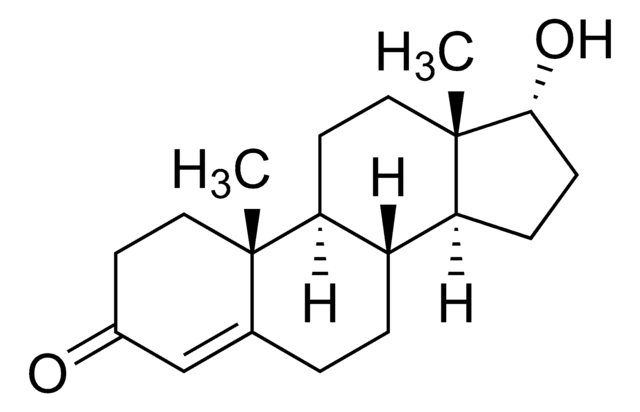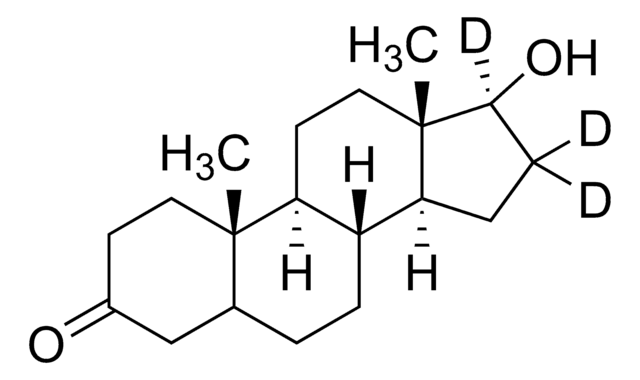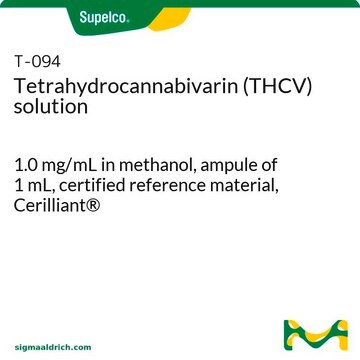T4764
Δ9-Tetrahydrocannabinol solution
1.0 mg/mL in methanol, analytical standard, for drug analysis
Synonyme(s) :
Δ1-Tetrahydrocannabinol
About This Item
Produits recommandés
Qualité
analytical standard, for drug analysis
Niveau de qualité
drug control
Home Office Schedule 2; stupéfiant (France); kontrollierte Droge in Deutschland; (Spain); Decreto Lei 15/93: Tabela IIB (Portugal)
Concentration
1.0 mg/mL in methanol
Technique(s)
HPLC: suitable
gas chromatography (GC): suitable
Application(s)
pharmaceutical (small molecule)
Format
single component solution
Température de stockage
2-8°C
Chaîne SMILES
[H][C@@]12CCC(C)=C[C@@]1([H])c3c(O)cc(CCCCC)cc3OC2(C)C
InChI
1S/C21H30O2/c1-5-6-7-8-15-12-18(22)20-16-11-14(2)9-10-17(16)21(3,4)23-19(20)13-15/h11-13,16-17,22H,5-10H2,1-4H3/t16-,17-/m1/s1
Clé InChI
CYQFCXCEBYINGO-IAGOWNOFSA-N
Informations sur le gène
human ... CNR1(1268) , CNR2(1269)
mouse ... Cnr1(12801)
rat ... Cnr1(25248)
Vous recherchez des produits similaires ? Visite Guide de comparaison des produits
Description générale
Application
- Development and validation of a high-performance liquid chromatographic method coupled with UV detection to measure cannabidiol and ∆9-tetrahydrocannabinol in rat plasma samples following their extraction by protein precipitation and liquid-liquid extraction (LLE)
- Estimation of cannabidiol and ∆9-tetrahydrocannabinol extracted from human plasma samples by liquid-liquid extraction using ultra-performance liquid chromatography with triple quadrupole mass spectrometry
- Multi-residue analysis of Δ9-tetrahydrocannabinol (THC) and its two degradation products, 11-hydroxy-Δ9-tetrahydrocannabinol and 11-nor-9-carboxy-Δ9-tetrahydrocannabinol, in whole blood samples by QuEChERS extraction and gas chromatography (GC) coupled with tandem mass spectrometry (MS/MS)
- Optimization of an ultra-high performance supercritical fluid chromatographic (UHPSFC) method, combined with a tandem mass spectrometer (MS/MS) to determine ∆9-tetrahydrocannabinol, along with three of its major metabolites and four synthetic metabolites in wastewater samples following liquid-liquid extraction
- Development and validation of an ultra high-performance liquid chromatographic (UHPLC) method coupled to photodiode array and mass spectrometry detectors to determine 11 cannabinoids in various Cannabis Sativa samples
Autres remarques
Mention d'avertissement
Danger
Mentions de danger
Conseils de prudence
Classification des risques
Acute Tox. 3 Dermal - Acute Tox. 3 Inhalation - Acute Tox. 3 Oral - Flam. Liq. 2 - STOT SE 1
Organes cibles
Eyes,Central nervous system
Code de la classe de stockage
3 - Flammable liquids
Classe de danger pour l'eau (WGK)
WGK 2
Point d'éclair (°F)
49.5 °F - closed cup
Point d'éclair (°C)
9.7 °C - closed cup
Équipement de protection individuelle
Eyeshields, Faceshields, Gloves, type ABEK (EN14387) respirator filter
Faites votre choix parmi les versions les plus récentes :
Déjà en possession de ce produit ?
Retrouvez la documentation relative aux produits que vous avez récemment achetés dans la Bibliothèque de documents.
Les clients ont également consulté
Articles
Tetrahydrocannabinolic acid A solution, 1.0 mg/mL in acetonitrile, ampule of 1 mL, certified reference material.
Notre équipe de scientifiques dispose d'une expérience dans tous les secteurs de la recherche, notamment en sciences de la vie, science des matériaux, synthèse chimique, chromatographie, analyse et dans de nombreux autres domaines..
Contacter notre Service technique














